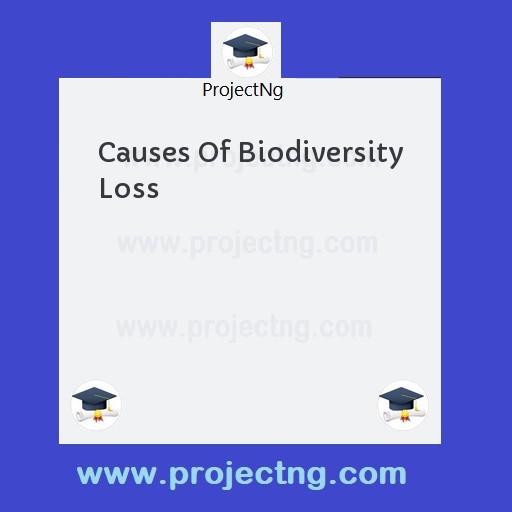Causes Of Biodiversity Loss
Seminars Project Topics
Get the Complete Project Materials Now! »
CAUSES OF BIODIVERSITY LOSS
TABLE OF CONTENTS
Title page - - - - - - - i
Abstract - - - - - - - - ii
Table of contents - - - - - - iii
CHAPTER ONE
1.0 Introduction - - - - - - 1
CHAPTER TWO
2.0 Causes of biodiversity loss - - -
2.1 Genetic Diversity - - - - -
2.2 Ecosystem Diversity - - - -
2.3 Species Diversity - - - - -
CHAPTER THREE
3.0 The Impacts of biodiversity loss - -
3.1 Impact on land use and land use and land scape - - - - - - - - -
3.2 Impact on marine biodiversity - -
3.3 Impact on water biodiversity - - - -
3.4 Impact on mining biodiversity - - -
CHAPTER FOUR
4.0 Conclusion - - - - - - -
4.1 Recommendation - - - - - -
References - - - - - - - -
CHAPTER ONE
1.0 INTRODUCTION
Biodiversity is contraction of “biological diversity” and refers to the number variety and variability of living organisms. In its widest sense, therefore, it is synonymous with “life on Earth”.
It embraces two different concepts: One is a measure of how many different living things they are and the other is the measure of how different the area (Unep, 1992) among citation. Although many definitions of biodiversity exist, the most often–cited is provided by the “convention on Biological diversity means the variability among living organisms from all sources including interalia, terrestrial, marine and other aquatic ecosystems and the ecological complexes of which they are part; this includes diversity within species, between species and of ecosytems” (Johnson, 1992).
The term “Biodiversity”, thus, refers to the variety of all life on earth, and explicitly recognizes how the interaction of the different components of ecosystems results in the provision of essential ecosystem services on the one hand, and social and recreational opportunities on the other including being a source of inspiration and cultural identity ” (Johnson, 1992).
A number of concepts have been developed in recent years relating to indicators and principles for biodiversity management including “ecosystem integrity”, “ecosystem health”, “Sustainability”, and “resilence” (The ability of an ecosystem to withstand stresses and shocks).
Perhaps, one of the simplest and most widely accepted definitions used is the conservation of the maximum number of species. But even then, there are difficulties, as it is not clear what actually constitutes a species. Some common concepts for differentiating species have been identified (Brookes, 1998).
- Biological species concept-defines a species as a group of interbreeding populations isolated from other such groups,
- Morphological species definition-defines a species according to a given set common features;
- Evolutionary species concept –defines a species by its shared evolutionary history; and
- Genotypic cluster definition –uses genetic “gaps” to distinguish one species from another.
By the 1990s, several international initiatives were focused on the more specific question of how the diversity of life forms impacts on ecosystems. The scientific committee on problems of the Environment (SCOPE) produced an influential book reviewing the state of knowledge on biodiversity and ecosystem functioning (BEF). (Schulze, ED. and Mooney, 1993).
Research on BEF had developed a large body of experiments and mathematical theory describing how genetic, species and functional diversity of organisms control basic ecological processes (functions) in ecosystems. Studies on biodiversity and ecosystem services (BES) were, in contrast, mostly correlative, conducted at the landscape scale and often focused on how major habital modifications influenced ‘Provisioning and regulating services of ecosystems’ (world Resources Institutes, 2005).
Be the First to Share On Social

Enjoying our content?
Don't miss out on new videos! Subscribe to our YouTube channel for more awesome content.
Subscribe Now!













